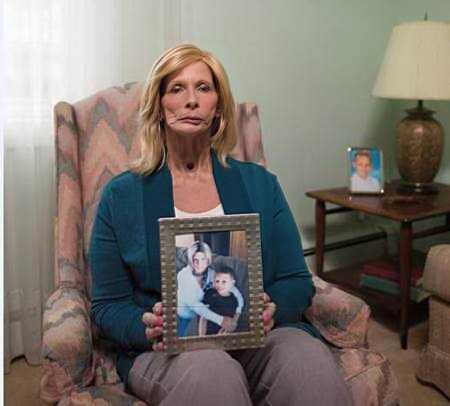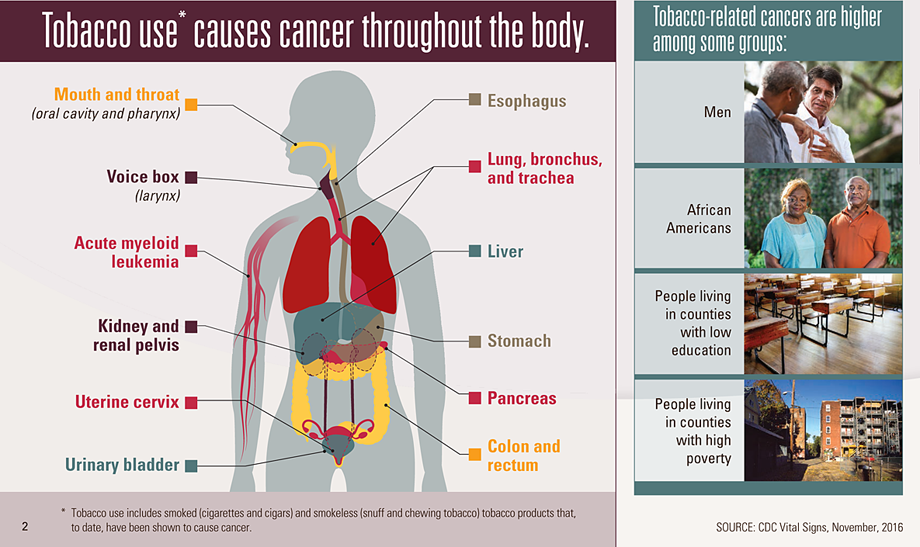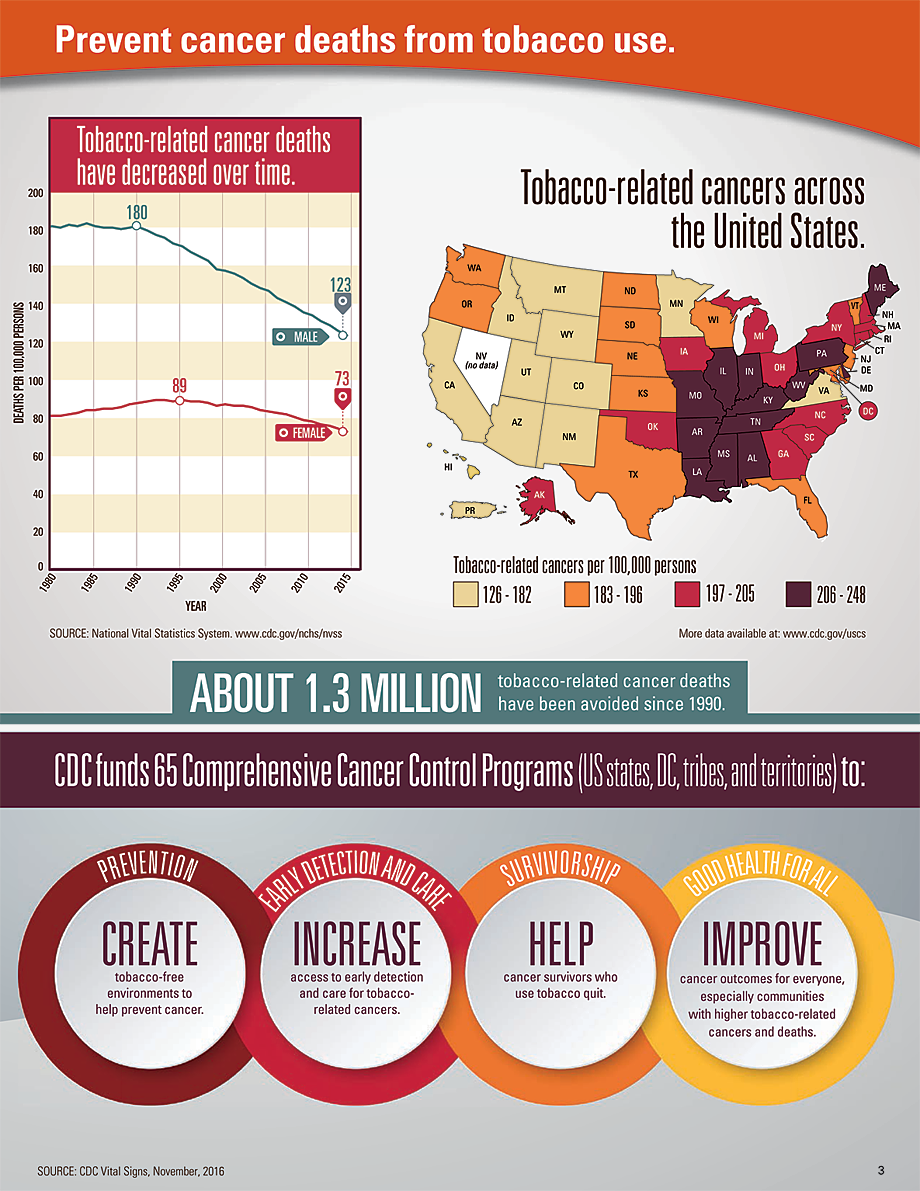Cancer and Tobacco Use
Tobacco use causes many cancers
On This Page
Overview
Tobacco use is the leading preventable cause of cancer and cancer deaths. It can cause not only lung cancer — but also cancers of the mouth and throat, voice box, esophagus, stomach, kidney, pancreas, liver, bladder, cervix, colon and rectum, and a type of leukemia. Each year, 660,000 people in the US are diagnosed with and 343,000 people die from a cancer related to tobacco use. We have made progress: more than 1 million tobacco-related cancer deaths have been avoided since 1990 because of comprehensive cancer and tobacco control programs, early detection of cancer, and improvements in cancer treatment. However, not all states or all people have experienced the benefits of these efforts. When states make greater and longer investments in comprehensive cancer and tobacco control programs, fewer people use tobacco and get or die from tobacco-related cancers.
States and communities can:
- Support comprehensive cancer control programs focusing on cancer prevention, education, screening, access to care, support for cancer survivors, and good health for all.
- Fund comprehensive tobacco prevention and control programs at CDC-recommended levels.
- Make tobacco cessation treatments more available to people who want to quit.
- Protect nonsmokers from secondhand smoke in all indoor public places and worksites, including all restaurants, bars, and casinos.

Problem
People are still dying from cancers caused by tobacco use.
People who use tobacco or are exposed to secondhand smoke are more likely to get and die from cancer.
- Tobacco smoke has at least 70 chemicals that cause cancer, also known as carcinogens.
- Lung and colorectal cancers make up more than half of all cancers linked to tobacco use.
- Secondhand smoke exposure causes about 7,300 lung cancer deaths among nonsmoking adults each year.
Tobacco use is the leading preventable cause of cancer and cancer deaths.
- About 3 in 10 cancer deaths are caused by cigarette smoking. Lung cancer is the leading cause of cancer death for both men and women.
- Quitting tobacco use at any age can reduce the risk of getting or dying from cancer.
- Getting screened for cancer can lead to fewer people getting or dying from some tobacco-related cancers (cervix, colorectal, and lung).
SOURCE: CDC Vital Signs, November, 2016
Infographics
What Can Be Done
The Federal government is
- Requiring most insurance plans to cover recommended cancer screenings, vaccinations, as well as counseling and medications to help people quit tobacco use at no cost to the patient through the Affordable Care Act.
- Funding state tobacco and cancer prevention and control programs to help reduce the number of people who get cancer caused by tobacco use.
- Funding programs that increase cervical and colorectal cancer screening rates.
- Regulating manufacturing, marketing, and distribution of tobacco products.
- Encouraging smokefree places that protect nonsmokers from secondhand smoke.
- Funding and promoting educational campaigns about tobacco use, information, and proven resources to help people quit tobacco use.
States and communities can
- Support comprehensive cancer control programs focusing on cancer prevention, education, screening, access to care, support for cancer survivors, and good health for all. www.cdc.gov/cancer/ncccp
- Fund comprehensive tobacco prevention and control programs at CDC-recommended levels. www.cdc.gov/tobacco/stateandcommunity/best_practices
- Make tobacco cessation treatments more available to people who want to quit.
- Protect nonsmokers from secondhand smoke in all indoor public places and worksites, including all restaurants, bars, and casinos.
Healthcare providers can
- Ask all patients whether they use tobacco products, advise those who do not use them not to start, encourage those who do to quit, and provide help with quitting.
- Help patients understand what cancer screening tests are needed and are best for them. Make sure their patients are screened on time.
- Let patients know that there is no risk-free level of exposure to secondhand smoke and advise them to avoid it.
- Know which screening and counseling services are reimbursable to their practice.
Everyone can
- Quit using tobacco or never start. Quitting at any age will help you avoid getting cancer. Ask a healthcare provider for help quitting and call 1-800-QUIT-NOW or go to www.smokefree.gov for free assistance.
- Encourage friends, family, and coworkers to quit using tobacco.
- Teach children and adolescents about the health risks of tobacco use and secondhand smoke exposure.
- Make their home and vehicle 100% tobacco free and not allow anyone to use any tobacco products around children.
- Learn what cancer screening tests and vaccines are right for them and their family.
Issue Details
Related Pages
- Vital Signs Issue details: Cancer and Tobacco Use, Morbidity and Mortality Weekly Report (MMWR)
- Vital Signs – Cancer and Tobacco Use [PODCAST – 1:15 minutes]
- Vital Signs – Cancer and Tobacco Use [PSA – 0:60 seconds]
- CDC Cancer Prevention and Control
- CDC Infographic: Lung Cancer Is the Biggest Cancer Killer in Both Men and Women
- CDC Lung Cancer Matte Article
- CDC’s Tips from Former Smokers Campaign
- CDC: The 6|18 Initiative: Accelerating Evidence into Action
- CDC Tobacco Control Interventions
- CDC’s Office on Smoking and Health
- CDC: Caring for Cancer Survivors Who Use Tobacco
- CDC: Tobacco and Cancer
Science Behind the Issue
- Page last reviewed: November 10, 2016
- Page last updated: November 10, 2016
- Content source:
- National Center for Chronic Disease Prevention and Health Promotion
- Page maintained by: Office of the Associate Director for Communications (OADC)


 ShareCompartir
ShareCompartir


